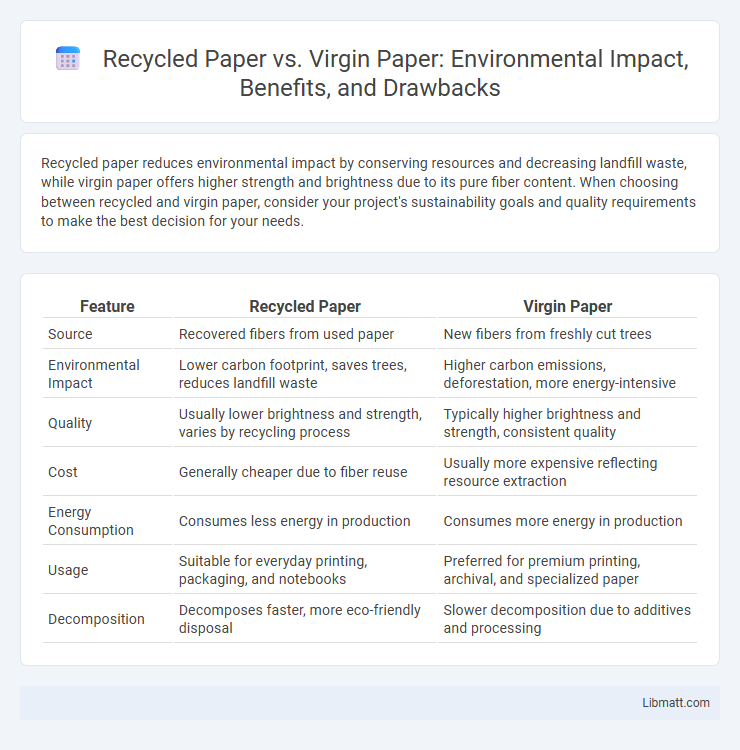Recycled paper reduces environmental impact by conserving resources and decreasing landfill waste, while virgin paper offers higher strength and brightness due to its pure fiber content. When choosing between recycled and virgin paper, consider your project's sustainability goals and quality requirements to make the best decision for your needs.
Table of Comparison
| Feature | Recycled Paper | Virgin Paper |
|---|---|---|
| Source | Recovered fibers from used paper | New fibers from freshly cut trees |
| Environmental Impact | Lower carbon footprint, saves trees, reduces landfill waste | Higher carbon emissions, deforestation, more energy-intensive |
| Quality | Usually lower brightness and strength, varies by recycling process | Typically higher brightness and strength, consistent quality |
| Cost | Generally cheaper due to fiber reuse | Usually more expensive reflecting resource extraction |
| Energy Consumption | Consumes less energy in production | Consumes more energy in production |
| Usage | Suitable for everyday printing, packaging, and notebooks | Preferred for premium printing, archival, and specialized paper |
| Decomposition | Decomposes faster, more eco-friendly disposal | Slower decomposition due to additives and processing |
Introduction to Recycled and Virgin Paper
Recycled paper is made from previously used paper fibers, reducing the need for virgin wood pulp and conserving natural resources, while virgin paper is produced directly from fresh wood pulp, offering higher strength and brightness. The environmental impact of recycled paper is significantly lower, with reduced energy consumption and fewer greenhouse gas emissions compared to virgin paper production. Your choice between recycled and virgin paper can influence sustainability efforts, cost, and quality depending on your specific usage needs.
Environmental Impact Comparison
Recycled paper reduces deforestation by using existing fibers, significantly lowering the demand for virgin pulp sourced from trees. Its production consumes up to 60% less water and generates 40% less air pollution compared to virgin paper manufacturing. Energy usage for recycled paper is typically 28-70% less, resulting in a smaller carbon footprint and reduced greenhouse gas emissions.
Manufacturing Processes Explained
Recycled paper manufacturing involves collecting used paper, removing ink through de-inking, and processing fibers to produce new paper, significantly reducing energy and water consumption compared to virgin paper production. Virgin paper manufacturing starts with harvesting trees, pulping wood chips chemically or mechanically, and bleaching the pulp for desired whiteness, which requires higher resource input and results in greater environmental impact. Both methods utilize advanced technologies to enhance fiber quality and paper strength, but recycled paper manufacturing emphasizes sustainability by minimizing deforestation and landfill usage.
Raw Material Sources
Recycled paper is made primarily from post-consumer waste, such as used office paper and cardboard, reducing the demand for virgin wood fiber and minimizing deforestation. Virgin paper, on the other hand, relies on fresh timber harvested directly from trees, often impacting forest ecosystems and biodiversity. Choosing recycled paper helps Your environmental footprint by conserving natural resources and lowering energy consumption associated with raw material processing.
Energy and Water Consumption
Recycled paper significantly reduces energy consumption by using up to 40% less energy compared to virgin paper production. Water usage also declines by approximately 50%, conserving vital resources and lowering your environmental footprint. Choosing recycled paper supports sustainable practices that minimize resource depletion and pollution.
Quality and Performance Differences
Recycled paper often contains shorter fibers, resulting in slightly lower strength and durability compared to virgin paper made from fresh wood pulp. Virgin paper typically offers superior brightness, smoothness, and print quality, making it preferable for high-end printing and publishing. However, advancements in recycling technology have significantly improved the performance of recycled paper, narrowing the quality gap for most everyday uses.
Cost Analysis: Recycled vs Virgin Paper
Recycled paper typically costs 10-30% less than virgin paper due to lower raw material expenses and reduced energy consumption during production. Virgin paper, sourced directly from trees, involves higher costs associated with forestry management, pulping, and bleaching processes. Market demand fluctuations and economies of scale further impact the price gap between recycled and virgin paper products.
Market Availability and Accessibility
Recycled paper is widely available in most retail and office supply stores, often at competitive prices, making it accessible for businesses and consumers focused on sustainability. Virgin paper, derived directly from wood pulp, tends to have broader variety and widespread distribution, especially in bulk quantities for specialized printing needs. Your choice may depend on balancing ecological impact with the specific availability of paper grades and finishes in your local market.
Common Applications and Uses
Recycled paper is widely used in packaging, printing, and office supplies due to its environmental benefits and cost-effectiveness. Virgin paper, made from fresh pulp, is preferred for applications requiring high strength and quality, such as premium books, official documents, and luxury packaging. Your choice between recycled and virgin paper depends on the durability, appearance, and sustainability needs of the project.
Future Trends in Paper Production
Future trends in paper production emphasize increased adoption of recycled paper to reduce environmental impact and conserve natural resources. Technological advancements are improving the quality and cost-effectiveness of recycled fibers, making recycled paper a competitive alternative to virgin paper. Your choices in using recycled paper can support sustainable practices and drive innovation toward circular economies in the paper industry.
Recycled paper vs virgin paper Infographic

 libmatt.com
libmatt.com